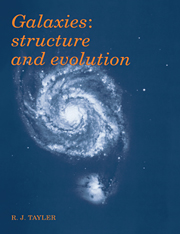Book contents
- Frontmatter
- Contents
- Preface
- Symbols
- Numerical values
- 1 Introduction
- 2 Observations of the Galaxy
- 3 Properties of external galaxies
- 4 Stellar dynamics
- 5 Masses of galaxies
- 6 The interstellar medium in our Galaxy
- 7 The chemical evolution of galaxies
- 8 Galaxies and the Universe
- 9 Concluding remarks
- Appendix 1 Some factors influencing stellar spectra
- Appendix 2 The Virial Theorem
- Appendix 3 Gravitational fields due to spheres and ellipsoids
- Suggestions for further reading
- Index
4 - Stellar dynamics
Published online by Cambridge University Press: 05 June 2012
- Frontmatter
- Contents
- Preface
- Symbols
- Numerical values
- 1 Introduction
- 2 Observations of the Galaxy
- 3 Properties of external galaxies
- 4 Stellar dynamics
- 5 Masses of galaxies
- 6 The interstellar medium in our Galaxy
- 7 The chemical evolution of galaxies
- 8 Galaxies and the Universe
- 9 Concluding remarks
- Appendix 1 Some factors influencing stellar spectra
- Appendix 2 The Virial Theorem
- Appendix 3 Gravitational fields due to spheres and ellipsoids
- Suggestions for further reading
- Index
Summary
Introduction
In this chapter I shall consider that a galaxy consists of stars alone. To a first approximation this is true of a real galaxy apart from the possibility of hidden mass in the form of weakly interacting elementary particles; in what follows the gravitational field of any hidden mass is assumed to be added to that of the stars. For most of the life history of a galaxy the mass in the form of stars is much greater than the mass of the interstellar gas and the stars exert a much stronger gravitational influence on the gas than the reverse. Although there is a continual mass exchange between the stars and the gas, this occurs slowly compared to the time taken by individual stars to travel about the galaxy, certainly once the formation phase of the galaxy is completed. To a large extent in what follows I shall refer to the Galaxy, but it may be regarded as typical of other galaxies.
The first point to be made about the Galaxy, if it is considered as a system of stars, is that to a good approximation stars may be regarded as point masses. Except in the densest regions of galaxies, stellar separations very much smaller than 1016 m are rare, whilst only the very largest stars have radii greater than 1010 m.
- Type
- Chapter
- Information
- GalaxiesStructure and Evolution, pp. 89 - 109Publisher: Cambridge University PressPrint publication year: 1993



